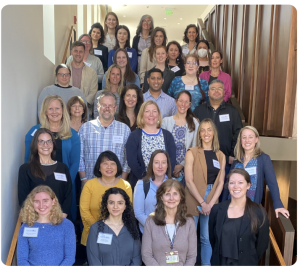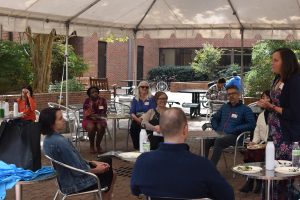With 2022 coming to an end, we want to reflect on the incredible work HPDP researchers, Community Advisors, and staff have done in the past year. From celebrating milestones in environmental justice, to reconnecting with each other in person again, to publishing innovative research, here are four powerful stories from the past year that inspires us as we look towards the future of public health:
CPCRN hosted first in person meeting in May 2022 since COVID

The Cancer Prevention and Control Research Network (CPCRN) is a thematic research network of the Center for Disease Control’s Prevention Research Centers (PRCs). The CPCRN Coordinating Center located at UNC coordinates and evaluates collaborative research focused on evidence-based cancer prevention and control strategies in communities.
In May 2022, members convened for the CPCRN5 Year 3 Annual Meeting. Serving as this year’s local host, the Colorado School of Public Health (CSPH) saw 46 attendees in Denver, marking the first in-person gathering since the CPCRN5 Kickoff Meeting in January 2020. 62 additional members joined remotely via Zoom. After over two years of fully virtual engagements, the members enjoyed time face-to-face time networking, planning, and working on future projects.

The Warren County African American Historical Collective (WCAAHC) 40th anniversary of the protests that launched the environmental justice movement
On September 17th, community members, university officials, activists, and clergy gathered at Coley Springs Missionary Baptist Church to celebrate the 40th anniversary of the protests that launched the environmental justice movement. The nonviolent Warren County protests fought against the state’s disposal of soil contaminated with PCBs (polychlorinated biphenyls) in the predominantly Black community.
Reverend Bill Kearney is a HPDP Community Advisory Board member and employee, associate minister at Coley Springs, and 2011 NC TraCS Research-Engaged Community Scholar (RECS). For Reverend Kearney the event is the culmination of efforts to empower the community to celebrate its place in combating environmental racism.
“We birthed a movement,” said Kearney. “Now we own this movement. We are on the front line when it comes to environmental social justice. And we’re going to demand reparation and to be made whole.”
Read the full story here.

Study published showing positive impacts of front-of-package warnings on sugar sweetened beverages
In February, a study published in the journal PLOS Medicine was the first to investigate how health warnings on sugary beverages influenced purchasing behaviors of parents in a realistic store setting. Located in the UNC Center for Health Promotion and Disease Prevention (HPDP) office space, the “UNC Mini Mart” is a laboratory set up to mimic a convenience store shopping experience. Researchers are then able to change certain variables, such as product labels, and investigate how those changes may impact shopping behavior.
“We created this store because we saw a major need for research that tests the impact of policies in a food store setting that is much more realistic. When people make choices about what food to buy, they are juggling dozens of factors like taste, cost and advertising and are looking at many products at once,” says senior author Lindsey Smith Taillie, PhD, assistant professor in the Department of Nutrition at Gillings and research fellow at HPDP.
In this study, parents of young children were asked to purchase a beverage for their child. Some parents were presented with 1) a picture warning arm (in which drink labels had images representing heart damage and Type 2 diabetes), and 2) a control arm (in which drink labels displayed a barcode). The picture warnings led to a 17-percentage point reduction in purchases of sugary drinks, with 45% of parents in the control arm buying a sugary drink for their child compared to 28% in the pictorial warning arm. The research team thinks that warning labels are a promising way for consumers to feel more empowered in their purchasing decisions, and lower purchasing of food and beverages linked to diet-related diseases.
“We think the paper could be useful for policymakers in the U.S. and globally,” says lead author Marissa G. Hall, PhD, assistant professor in Gillings’ Department of Health Behavior. “This evidence supports strong front-of-package warnings to reduce children’s sugary drink consumption.”
Read the full story here.
HPDP hosts first in-person fellows luncheon at Gillings in over two years

This past September, HPDP hosted the first in-person luncheon for Research Fellows in over two years. The luncheon was held at a courtyard outside of the Gillings School of Global Public Health. This was an opportunity for research fellows, staff, and our director to connect, share expertise and current projects, and learn from each other. We hope to plan more in-person events for our fellows, staff, and partners to foster learning and collaboration between research and communities.
